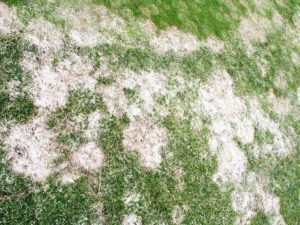Snow Mold on Lawns

Here in the Inland Northwest, we’ve been buried under a heavy blanket of snow for months. It’s wonderful for insulating our plants against bitterly cold winter temperatures. But it can cause an interesting (and annoying) problem that most of us will likely see. Once the snow has melted from our lawns, we’ll discover snow mold.
That’s the weird stuff you’re looking at in these photos. Tim Kohlhauff, Spokane County Urban Horticulture Coordinator, shared them with me.
What is snow mold?
As you might guess, snow mold is caused by a fungus. There are two types, gray snow mold (Typhula species) and pink snow mold (Microdochium nivalis). While the gray form can be referred to as Typhula blight, pink snow mold is also known as Fusarium patch. Gray snow mold is more typically seen on the east side of the Cascades. But pink snow mold can occur on golf course greens in this region as well.
Both of these problems molds occur when the snow starts covering the lawn before it’s had a chance to freeze. If it’s present in your lawn, you’ll first see small white patches of dried-out lawn.
Lawns that were fed with high-nitrogen fertilizers in the fall are more susceptible to snow mold. This is a practice that should be avoided. The sources I consulted recommend keeping your lawn mowed quite short in the fall. That way, it won’t have a tendency to fall over and create a mat. Those mats are more susceptible to fungal development.
The good news is that even though it looks dreadful, it’s not as horrific as you might think. Wait until the lawn is dry enough for you to walk on. When it’s too wet, you’ll compact the lawn’s roots and leave divots where you stepped. Rake out the dry patches of lawn to interrupt the development of more fungus. Discard the raked grass in your trash since it can contain fungal spores. The lawn should recover at this point.
Tim Kohlhauff’s helpful tips for dealing with snow mold:
“If you fertilize your lawn in the fall (especially late fall, like October or later), use slow-release form of nitrogen. The Labor Day (and Halloween) applications should be slow-release. Although even that isn’t a guarantee. Bringing mowing height down in the fall does help prevent snow mold.”
“Homeowners with gray snow mold should rake out the patches in the spring. That will open the turf ‘canopy’ to air movement and sun. With the sunlight and heat, the fungus will become less active. In most cases the grass will grow out of the disease on its own as it comes out of dormancy. If the grass is recovering, then it can go on its regular maintenance program.
“What if the grass doesn’t seem to be recovering, but the affected areas are dead? Then a person can wait for the turf to fill in on its own. That may take until June, or they can over-seed. To do this, they should rake out the patch. Then add a small amount of compost, and over-seed. They will have to treat the seeded area like any grass seedlings. Keep the area consistently moist but not wet. Do not mow, fertilize, or apply herbicides in the area until the turf is established.”

